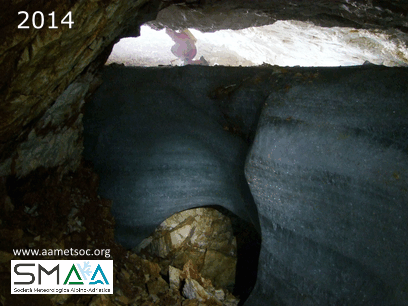November 23rd a small team composed of three research scientists representing the Institute of Polar Science - CNR, the Alpine-Adriatic Meteorological Society, and the speleological group Eugenio Boegan Cave Commission, reached two of the long-term monitoring caves interested by permanent ice deposits in the Julian Alps.
These caves have been under monitoring for 10 years now, and surely represent the most studied ice caves in the southern Alps and one of the most studied ice caves in the Alps. What has been mainly done here is a mass balance monitoring of the ice deposits beside permafrost behave.

Photo credits Andrea Securo
Since 2011, Renato R. Colucci, who is leading the ice cave research in the southeastern Alps, and colleagues reach several high altitude caves in the Canin mountain chain to check the ice situation. They perform mass balance measurements, download data loggers recording the temperature of the cave's air and the hosting rock, and make a set of observations of different parameters.
One of those is the presence of cryogenic calcite which was firstly found in one cave of the Canin massif, and represents the first and only find of this sort in the Southern Alps. You can follow this link to read the paper published in 2016 First Alpine evidence of in-situ coarse cryogenic cave carbonate (CCCcoarse).

Renato R. Colucci (ISP-CNR, CGEB, SMA-A) and Costanza Del Gobbo (SMA-A) checking the status of air-temperature dataloggers. Photo credits Andrea Securo
Microclimatic conditions in different caves of the Canin massif started 10 years ago thanks to the Alpine-Adriatic Meteorological Society (at that time Unione Meteorologica del Friuli Venezia Giulia) thanks to the financial support of the Comunità Montana del Gemonese, Canal del Ferro e Valcanale.
Thanks to this first attempt, in the following years it was possible disentangling several aspects of the present behave of such peculiar environments of the Alps, typical of the karstic plateaus located at high elevation.

Photo credits Andrea Securo
One of the main goals of the present survey is to monitor the present melting occurring in these environments. If several caves with ice deposits already showed dramatic signs of ice retreat in the past decades, few caves located at higher altitudes were apparently still in equilibrium with the present climate, as the one presented here.
Starting from 2014, instead, a set of events described in 2 scientific papers published in 2016 (Response of Ice Caves to weather Extremes) and 2019 (Climate change and rapid ice melt; suggestions from abrupt permafrost degradation and ice melting in an alpine ice cave), triggered abrupt ice melting associated to a fast increase in the temperature of the rock. This, in turn, brought to the degradation of permafrost in the rock walls of the cave suddenly changing the thermodynamic characteristics of this cave.
In the animation below you can see how much ice melted in just 6 years, from Autumn 2014 to Autumn 2021

Photo credits Renato R. Colucci & Andrea Securo
The research activities on the underground cryosphere in the karst areas of Friuli Venezia Giulia are now being carried out by the project CryoKarst (Cryosphere in the Karstic environments of Friuli Venezia Giulia) thanks to an operational agreement between the Institue of Polar Sciences (CNR) and the Geological Service of the Autonomous Region Friuli Venezia Giulia
